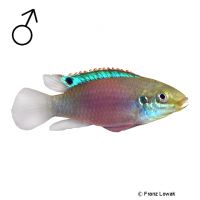Blue Fin Pelviachromis (Enigmatochromis lucanusi)
| Blue Fin Pelviachromis Enigmatochromis lucanusi | |
|---|---|
| Name | Blue Fin Pelviachromis |
| Name Lat. | Enigmatochromis lucanusi |
| Synonym | Pelviachromis sp. Blue Fin |
| Family | Cichlids |
| Family lat. | Cichlidae |
| Order | Cichlids |
| Order lat. | Cichliformes |
| Origin | Africa |
| Habitat | Forest streams |
| Diet | Carnivore |
| pH | 6.0-7.5 |
| Behavior | Semi-aggressive |
| Keeping | Pair |
| Care Level | Moderate |
| Reproduction | Cave spawner |
| Breeding | Moderately difficult |
| Life Span | 5-8 years |
| Protection | No |
| Metric Units | |
| Size | 8-10 cm |
| Temperature | 24-27 °C |
| Hardness | 1-15 °dH |
| Aquarium | 80 cm / 110 l |
| US Units | |
| Size | 3.1"-3.9" |
| Temperature | 75-81 °F |
| Hardness | 18-267 ppm |
| Aquarium | 30 gal |
Distribution and habitat
Bluegill are endemic to the Foto River, a small savanna river near Fria, in Guinea, West Africa. This small forest river with clear water is only 3-6 meters wide and 30-90 cm deep. The bottom of fine pebbles is covered with numerous larger stones and rocks.
Maintenance
The aquarium should have a dense border planting, with many hiding places, such as stones, roots and caves (e.g. halved coconuts) and offer free swimming space. Soft, slightly acidic water and a dark, graveable substrate of sand or gravel covered with some foliage (sea almond leaves) is ideal.
No ammonia, ammonium and nitrite should be detectable, the nitrate value should not exceed 100 mg/l. To ensure the water quality and oxygen content, a filter and heater adapted to the aquarium size is required, as well as lighting for the species-appropriate day-night rhythm of the animals.
Diet
They require live food, such as daphnia, cyclops, artemia, mysis and black mosquito larvae, which is also accepted without problems in frozen form, supplemented with commercially available frozen special food mixtures. Also high-quality, protein-rich dry food (flakes, granules, pellets, tablets) for cichlids is accepted without problems.
Only as much should be fed as is eaten in a few minutes. It is recommended to feed small portions several times a day. Regular and varied feeding promotes health and prevents deficiency symptoms
Behaviour and compatibility
The quiet, somewhat shy fish form solid pairs and defend their territory very emphatically during the spawning season. Keeping several pairs is only recommended in a larger and richly structured tank. They can be well socialized with not too lively fish.
Basically, only compatible fish species with similar demands on water quality and water temperature may be socialized.
Sex dimorphism
The male is larger, more colorful and has much longer, pointed fins. The female is smaller and rounder with a purple belly.
Reproduction and breeding
They are cave breeders and usually attach the spawn to the cave ceiling or walls. The female performs brood care, while the male defends the territory (parental family). The fry hatch after about 3 days and swim free after 8-9 days. Both parents continue to guard the fry for 5-6 weeks and lead them to feeding sites in the aquarium before brood care ends
Fry must be fed several times a day with special rearing food (Artemia nauplii). In community tanks breeding is hardly possible, because the fry are easy prey.
Important
The animals dig a lot, so special attention should be paid to stable stone structures
The well-being of the fish should be checked regularly. The temperature should be checked daily, the pH value, hardness and nitrate value at least every 14 days. Regular partial water changes are recommended, even if the pollutant load has not yet reached the upper limit. Sudden changes in water quality should be avoided. Newly introduced fish must be accustomed slowly to the water in the aquarium.
Further literature can be found in your pet store.
References
Text: Werner Winter; Image: Franz Lowak
Source: BMELV (1998): Tierschutzgutachten - Haltung von Zierfischen (Süßwasser); ENGELMANN (2005): Zootierhaltung - Tiere in menschlicher Obhut: Fische, Verlag Harri Deutsch
- Gemäß § 21 Abs. 5 Tierschutzgesetz idgF
